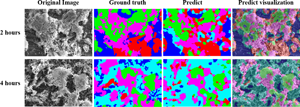Article contents
Detection and Identification of the Stages of DH5-Alpha Escherichia coli Biofilm Formation on Metal by Using an Artificial Intelligence System
Published online by Cambridge University Press: 04 August 2021
Abstract

In clinical environments, orthopedic implants are associated with a risk of infection during implantation. However, the growth paths of bacteria on metal, which is nontransparent, are difficult to observe. In this study, we visualized the DH5-alpha Escherichia coli bacterial growth path on the surface of magnesium by using scanning electron microscope (SEM) images and constructed a convolutional neural network-based artificial intelligence (AI) system to identify metal surfaces, bacteria, and its generated products to grade the growth stage of the bacteria implanted on the magnesium. The detection result of the E. coli growth stage by the AI system was close to that manually marked by experts, and it may greatly accelerate the investigation of the bacterial growth process in various types of metallic material.
- Type
- Biological Applications
- Information
- Copyright
- Copyright © The Author(s), 2021. Published by Cambridge University Press on behalf of the Microscopy Society of America
References
- 2
- Cited by





